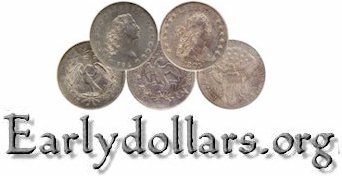

|
Production of Draped Bust dollars dated 1800 was quite substantial, but somewhat less than the total mintages of 1798 or 1799. A large number of dies were needed, and the mintage ultimately used 12 known different obverse dies and 11 known different reverse dies. These combined to create 16 different individual die varieties and multiple Redbook types. The Redbook categorizes these by characteristics of the date, the number of arrows on the reverse, and by a curious engraving error in the reverse legend. The presence of these features creates six different Redbook types. Date styles of 1800 dollars appear either with a normal “close” spacing of the numerals or with a very “wide” spacing. The most widely spaced date also depicts the numeral “8” as being too low and out of alignment. (One of the close date obverses also displays this “low 8” feature, but that variety is not presently recognized as a separate Redbook type.) An estimated 3,200 specimens remain of the normal date/normal design dollars, and there are approximately 1,100 specimens of the “Very Wide Date/Low 8” variety still in existence. An additional date variety resulted from the use of a rusted obverse die. Recessed rust pits on the die created raised lumps of metal on the struck coins - particularly noticeable in the date area of the coin. This so-called “dotted date” is quite popular with collectors. An estimated 700 specimens exist in all grades combined. |
|
|
|
|
|
Normal Close Date |
Close Date Low 8 |
|
|
|
|
Wide Date Low 8 |
Dotted Date |
|
All but two reverse dies for 1800 show the eagle holding a full complement of 13 arrows. On one of the remaining two reverses, the eagle holds only 12 arrows, and on the final reverse, the eagle holds only 10 complete arrows. Approximately 700 specimens remain of the “12 Arrows “ type, whereas only 400 specimens remain of the “10 Arrows” type. |
|
|
|
|
|
12 Arrows Reverse |
10 Arrows Reverse |
|
The final Redbook variety of 1800 dollar displays a very curious engraving error in the reverse legend. There appears a raised line following the word “AMERICA,” making the legend seem to read as “AMERICAI.” Perhaps the extra line was the mistaken beginning of a misplaced letter “A,” or perhaps it was simply an inadvertent scratch on the die. In any case, the “Americai” variety is inordinately popular with collectors today. This reverse is found matched with both the normal date obverse and with the wide date low 8 obverse. An estimated 1,100 combined specimens of both varieties still exist in all grades. |
|
|
|
|
|
AMERICAI Reverse |
|
|
The majority of 1800 reverse dies exhibit the motto “E PLURIBUS UNUM” using a new, larger lettered font that continued in use throughout the remaining production of early dollars. One 1800 reverse, however, used the smaller font which had been the standard in 1798 and 1799. |
|
|
|
|
|
Small Motto — Reverse of 1799 |
|
|
|
|
|
Large Motto — Normal Reverse |
|
|
One final distinctive variety of 1800 dollar displays a reverse variously labeled the “comet reverse,” “shooting star reverse,” or “sprays reverse.” On this variety, the obverse and reverse dies clashed together numerous times, leaving a spray of additional raised lines appearing much like tails to the uppermost stars on the reverse. |
|
|
|
|
|
“Comet” or Shooting Stars Reverse |
|
|
|
|
|
Normal Stars Reverse |
|